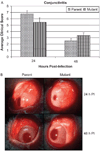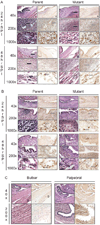Assessment of Streptococcus pneumoniae capsule in conjunctivitis and keratitis in vivo neuraminidase activity increases in nonencapsulated pneumococci following conjunctival infection
- PMID: 20795860
- PMCID: PMC2997481
- DOI: 10.3109/02713683.2010.492462
Assessment of Streptococcus pneumoniae capsule in conjunctivitis and keratitis in vivo neuraminidase activity increases in nonencapsulated pneumococci following conjunctival infection
Abstract
Purpose: The pneumococcal capsule is required for pathogenesis in systemic infections, yet reports show most conjunctivitis outbreaks are caused by nonencapsulated pneumococci, while keratitis infections are caused by encapsulated strains. This study aims to determine the effect of capsule in pneumococcal keratitis and conjunctivitis in rabbit models of infection.
Methods: A capsule-deficient isogenic mutant was created using homologous transformation. Parent and mutant strains were injected within the upper bulbar conjunctiva (conjunctivitis) or into the corneal stroma (keratitis) of New Zealand white rabbits. Clinical examinations were performed 24 and 48 hr post-infection at which time corneas or conjunctivae were removed, homogenized, and plated to determine the recovered bacterial load. Whole eyes were removed for histological examination. The neuraminidase activity was determined following in vitro and in vivo growth.
Results: There were no significant differences in clinical scores between the eyes infected with the parent or mutant for either infection, nor was there a difference in the amount of bacteria recovered from the cornea. In the conjunctivae, however, the mutant strain was cleared by the host faster than the parent strain. Histological examination showed slightly more infiltrating polymorphonuclear leukocytes (PMN) and macrophages in the conjunctivae infected with the parent strain. The neuraminidase activity of both strains was not significantly different when the strains were grown in vitro. However, the neuraminidase activity of the parent was significantly less than that of the mutant at 3 and 12 hr post conjunctival infection.
Conclusions: Although more outbreaks of pneumococcal conjunctivitis are tied to nonencapsulated S. pneumoniae strains, this study showed that an encapsulated strain was capable of establishing conjunctivitis in a rabbit injection model and survive attack by the host immune system longer than its nonencapsulated isogenic mutant. Nonetheless, the nonencapsulated pneumococci had an increased neuraminidase activity level in vivo when compared to the parent strain.
Conflict of interest statement
Figures





References
-
- Bhave P, Chamie G. Streptococcus pneumoniae keratitis. J Hosp Med. 2008;3:353. - PubMed
-
- Bharathi MJ, Ramakrishnan R, Vasu S, et al. Epidemiology of bacterial keratitis in a referral centre in South India. Indian J Med Microbiol. 2003;21:239–245. - PubMed
-
- Martin M, Turco JH, Zegans ME, et al. An outbreak of conjunctivitis due to atypical Streptococcus pneumoniae. N Engl J Med. 2003;348:1112–1121. - PubMed
-
- Crum NF, Barrozo CP, Chapman FA, et al. An outbreak of conjunctivitis due to a novel unencapsulated Streptococcus pneumoniae among military trainees. Clin Infect Dis. 2004;39:1148–1154. - PubMed
Publication types
MeSH terms
Substances
Grants and funding
LinkOut - more resources
Full Text Sources
Medical
